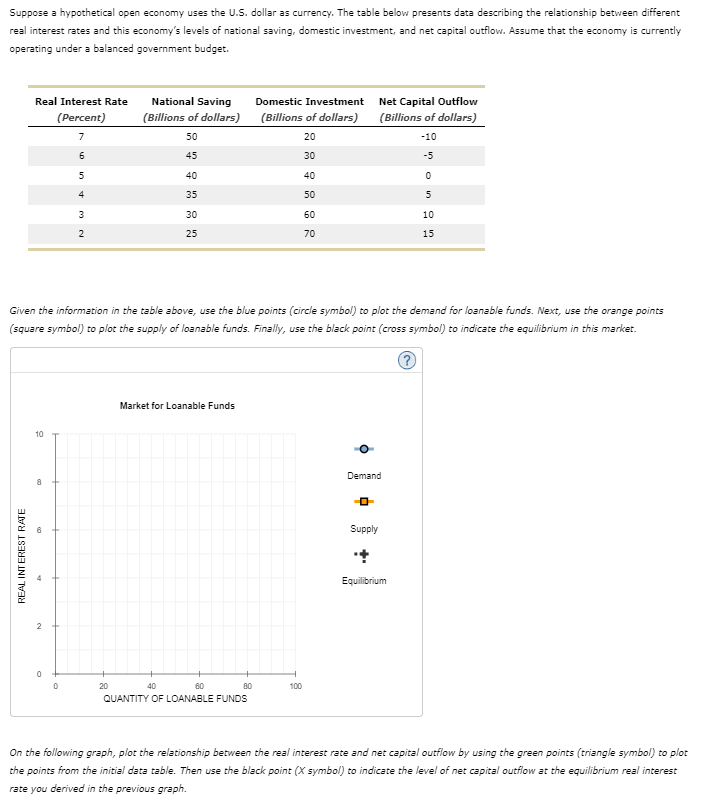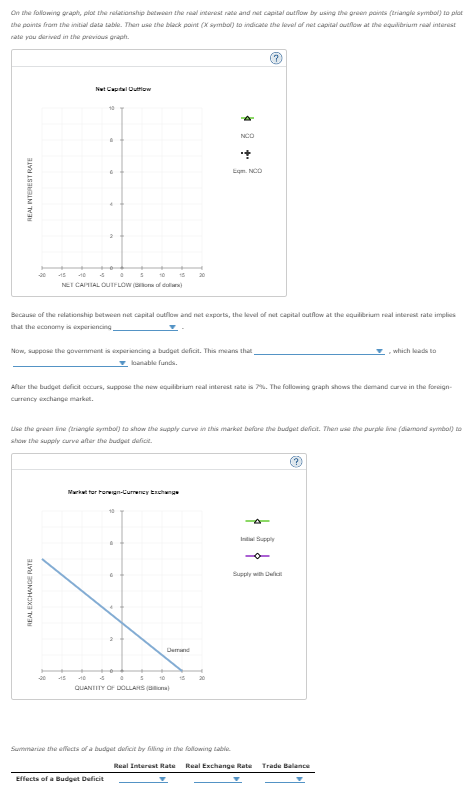Suppose a hypothetical open economy uses the U.S. dollar as currency. The table below presents data describing the relationship between different real interest rates and this economy's levels of national saving, domestic investment, and net capital outflow. Assume that the economy is currently operating under a balanced government budget. Real Interest Rate (Percent) National Saving (Billions of dollars) Domestic Investment (Billions of dollars) Net Capital Outflow 7 50 20 6 45 30 (Billions of dollars) -10 -5 5 40 40 0 4 35 50 5 3 30 60 10 2 25 70 R 15 Given the information in the table above, use the blue points (circle symbol) to plot the demand for loanable funds. Next, use the orange points (square symbol) to plot the supply of loanable funds. Finally, use the black point (cross symbol) to indicate the equilibrium in this market. 10 m REAL INTEREST RATE 2 Market for Loanable Funds 0 20 40 QUANTITY OF LOANABLE FUNDS 60 80 100 Demand -0- Supply + Equilibrium On the following graph, plot the relationship between the real interest rate and net capital outflow by using the green points (triangle symbol) to plot the points from the initial data table. Then use the black point (X symbol) to indicate the level of net capital outflow at the equilibrium real interest rate you derived in the previous graph. On the following graph, plot the relationship between the real interest rate and not capital outflow by using the green paints (triangle symbol) to plot the points from the initial data table. Then use the black point (X symbol) to indicate the level of net capital outflow at the equilibrium real interest rate you derived in the previous graph. REAL INTEREST RATE -20 -15 -10 NetCapital Outflow 10 . 5 10 15 20 NET CAPITAL OUTFLOW (of) NCO + ENCO (?) Because of the relationship between net capital outflow and net exports, the level of net capital outflow at the equilibrium real interest rate implies that the economy is experiencing Now, suppose the government is experiencing a budget deficit. This means that ..which leads to ▼loanable funds. After the budget deficit occurs, suppose the new equilibrium real interest rate is 7%. The following graph shows the demand curve in the foreign- currency exchange market. Use the green line (triangle symbol) to show the supply curve in this market before the budget deficit. Then use the purple line (diamond symbol) to show the supply curve after the budget deficit. REAL EXCHANGE RATE Market for Foreign-Currency Eng Demand 20 -15 -10 3 0 S 10 15 20 QUANTITY OF DOLLARS() Summarize the effects of a budget deficit by filling in the following table. InSupply Supply with w ? Real Interest Rate Real Exchange Rate Trade Balance Effects of a Budget Deficit
Suppose a hypothetical open economy uses the U.S. dollar as currency. The table below presents data describing the relationship between different real interest rates and this economy's levels of national saving, domestic investment, and net capital outflow. Assume that the economy is currently operating under a balanced government budget. Real Interest Rate (Percent) National Saving (Billions of dollars) Domestic Investment (Billions of dollars) Net Capital Outflow 7 50 20 6 45 30 (Billions of dollars) -10 -5 5 40 40 0 4 35 50 5 3 30 60 10 2 25 70 R 15 Given the information in the table above, use the blue points (circle symbol) to plot the demand for loanable funds. Next, use the orange points (square symbol) to plot the supply of loanable funds. Finally, use the black point (cross symbol) to indicate the equilibrium in this market. 10 m REAL INTEREST RATE 2 Market for Loanable Funds 0 20 40 QUANTITY OF LOANABLE FUNDS 60 80 100 Demand -0- Supply + Equilibrium On the following graph, plot the relationship between the real interest rate and net capital outflow by using the green points (triangle symbol) to plot the points from the initial data table. Then use the black point (X symbol) to indicate the level of net capital outflow at the equilibrium real interest rate you derived in the previous graph. On the following graph, plot the relationship between the real interest rate and not capital outflow by using the green paints (triangle symbol) to plot the points from the initial data table. Then use the black point (X symbol) to indicate the level of net capital outflow at the equilibrium real interest rate you derived in the previous graph. REAL INTEREST RATE -20 -15 -10 NetCapital Outflow 10 . 5 10 15 20 NET CAPITAL OUTFLOW (of) NCO + ENCO (?) Because of the relationship between net capital outflow and net exports, the level of net capital outflow at the equilibrium real interest rate implies that the economy is experiencing Now, suppose the government is experiencing a budget deficit. This means that ..which leads to ▼loanable funds. After the budget deficit occurs, suppose the new equilibrium real interest rate is 7%. The following graph shows the demand curve in the foreign- currency exchange market. Use the green line (triangle symbol) to show the supply curve in this market before the budget deficit. Then use the purple line (diamond symbol) to show the supply curve after the budget deficit. REAL EXCHANGE RATE Market for Foreign-Currency Eng Demand 20 -15 -10 3 0 S 10 15 20 QUANTITY OF DOLLARS() Summarize the effects of a budget deficit by filling in the following table. InSupply Supply with w ? Real Interest Rate Real Exchange Rate Trade Balance Effects of a Budget Deficit
Principles of Economics 2e
2nd Edition
ISBN:9781947172364
Author:Steven A. Greenlaw; David Shapiro
Publisher:Steven A. Greenlaw; David Shapiro
Chapter31: The Impacts Of Government Borrowing
Section: Chapter Questions
Problem 3SCQ: In the late 1990s, the U.S. government moved from a budget deficit to a budget surplus and the trade...
Question

Transcribed Image Text:Suppose a hypothetical open economy uses the U.S. dollar as currency. The table below presents data describing the relationship between different
real interest rates and this economy's levels of national saving, domestic investment, and net capital outflow. Assume that the economy is currently
operating under a balanced government budget.
Real Interest Rate
(Percent)
National Saving
(Billions of dollars)
Domestic Investment
(Billions of dollars)
Net Capital Outflow
7
50
20
6
45
30
(Billions of dollars)
-10
-5
5
40
40
0
4
35
50
5
3
30
60
10
2
25
70
R
15
Given the information in the table above, use the blue points (circle symbol) to plot the demand for loanable funds. Next, use the orange points
(square symbol) to plot the supply of loanable funds. Finally, use the black point (cross symbol) to indicate the equilibrium in this market.
10
m
REAL INTEREST RATE
2
Market for Loanable Funds
0
20
40
QUANTITY OF LOANABLE FUNDS
60
80
100
Demand
-0-
Supply
+
Equilibrium
On the following graph, plot the relationship between the real interest rate and net capital outflow by using the green points (triangle symbol) to plot
the points from the initial data table. Then use the black point (X symbol) to indicate the level of net capital outflow at the equilibrium real interest
rate you derived in the previous graph.

Transcribed Image Text:On the following graph, plot the relationship between the real interest rate and not capital outflow by using the green paints (triangle symbol) to plot
the points from the initial data table. Then use the black point (X symbol) to indicate the level of net capital outflow at the equilibrium real interest
rate you derived in the previous graph.
REAL INTEREST RATE
-20 -15
-10
NetCapital Outflow
10
.
5
10
15
20
NET CAPITAL OUTFLOW (of)
NCO
+
ENCO
(?)
Because of the relationship between net capital outflow and net exports, the level of net capital outflow at the equilibrium real interest rate implies
that the economy is experiencing
Now, suppose the government is experiencing a budget deficit. This means that
..which leads to
▼loanable funds.
After the budget deficit occurs, suppose the new equilibrium real interest rate is 7%. The following graph shows the demand curve in the foreign-
currency exchange market.
Use the green line (triangle symbol) to show the supply curve in this market before the budget deficit. Then use the purple line (diamond symbol) to
show the supply curve after the budget deficit.
REAL EXCHANGE RATE
Market for Foreign-Currency Eng
Demand
20
-15
-10
3
0
S
10
15
20
QUANTITY OF DOLLARS()
Summarize the effects of a budget deficit by filling in the following table.
InSupply
Supply with w
?
Real Interest Rate Real Exchange Rate
Trade Balance
Effects of a Budget Deficit
Expert Solution
This question has been solved!
Explore an expertly crafted, step-by-step solution for a thorough understanding of key concepts.
This is a popular solution!
Trending now
This is a popular solution!
Step by step
Solved in 2 steps

Recommended textbooks for you

Principles of Economics 2e
Economics
ISBN:
9781947172364
Author:
Steven A. Greenlaw; David Shapiro
Publisher:
OpenStax

Brief Principles of Macroeconomics (MindTap Cours…
Economics
ISBN:
9781337091985
Author:
N. Gregory Mankiw
Publisher:
Cengage Learning

Essentials of Economics (MindTap Course List)
Economics
ISBN:
9781337091992
Author:
N. Gregory Mankiw
Publisher:
Cengage Learning

Principles of Economics 2e
Economics
ISBN:
9781947172364
Author:
Steven A. Greenlaw; David Shapiro
Publisher:
OpenStax

Brief Principles of Macroeconomics (MindTap Cours…
Economics
ISBN:
9781337091985
Author:
N. Gregory Mankiw
Publisher:
Cengage Learning

Essentials of Economics (MindTap Course List)
Economics
ISBN:
9781337091992
Author:
N. Gregory Mankiw
Publisher:
Cengage Learning